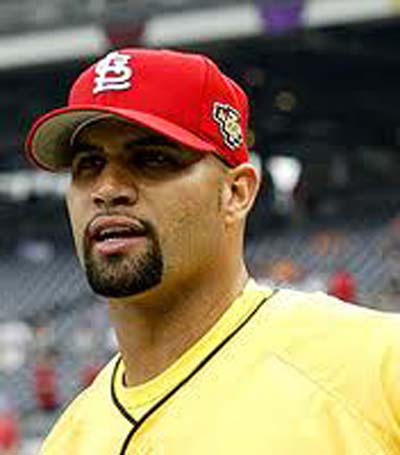I came across a very interesting article last week when my new edition (July 29) of Sports Illustrated arrived. The article was titled “Why Pujols Can’t (And A-Rod Wouldn’t) Touch This Pitch.”
It began with an explanation as to why a great female softball pitcher and Olympic gold medallist named Jennie Finch had so much success striking out major league standouts like Albert Pujols and Barry Bonds among others when those individuals had been willing to step into the batter’s box and try and hit her 95-mph softball pitches.
Albert Pujols
The reason those professionals found it next to impossible to hit her pitches may surprise you. It has nothing to do with the fact they were thrown from a mound 43 feet away from those batters as opposed to the standard distance of 60 feet, six inches they are used to having pitchers throw from in the major leagues.
It also had nothing to do with the speed of her pitches. Major league batters are used to facing big league pitchers throwing over 95-mph and can often hit those pitches with smaller size baseballs.
So, why couldn’t they hit the larger ball thrown the same speed by Ms. Finch?
Well, according to the article a typical major league fastball travels about 10 feet in just 75 milliseconds and it takes that long for the sensory cells in the eye retina to even confirm that a baseball is in view and for information about the flight path and velocity of the ball to be relayed to the brain.
The entire flight of the ball from the pitcher’s hand to the plate takes about just 400 milliseconds. They claimed it takes half that time simply to initiate muscular action, so in effect the batter has to decide if he is going to swing his bat and where before the ball is even halfway to the plate!
The window of opportunity for making contact with the ball when it’s actually in reach of the bat is said to be so small, and the angle of the ball relative to the hitter’s eye changing so quickly, that the coaching advice to keep your eye on the ball is apparently physically impossible to do.
So, how do major league batters even manage to enjoy as much success hitting a ball as they do?
Well, according to studies that track eye movements of experienced performers, such as elite athletes, as they gain experience they are quicker to sift through the irrelevant visual input and process the most important data on which to base their next move.
So, in the case of a major league batter they are very quickly able to make a decision as to whether or not to swing at a pitch and where to swing their bat based on a number of visual cues they see during the pitcher’s windup in terms of their body movements and release to unconsciously predict what will happen next based on their experience facing that particular pitcher or similar type of pitchers.
It works the same way for a tennis player who has to try and return a 130-mph serve.
But, when those same major league hitters have to try and face a world class softball pitcher throwing a pitch coming to the plate just as quickly, but being thrown using an underhand windmill motion they have no such frame of reference to draw upon in terms of visual clues to predict the future.
As a result, they suddenly find themselves back to square one and are badly overmatched.
The reality is most collegiate level females would fare much better hitting against Ms. Finch than major league batters would because of their experience facing that kind of pitching, at least until those big league hitters gained enough experience against that style they’d be able to begin picking up and acting upon a new set of visual cues that would benefit them against that type of pitching.
There was obviously a lot more information contained in the five-page article than I have room to share here, including an explanation of how elite athletes “chunk” information about bodies and players’ positioning to more quickly and unconsciously predict what will happen in the future.
I have to say I found it all very fascinating. I immediately began to think of the possible ramifications of this information in terms of how one should go about coaching youth sports, both in terms of developing strategies against the opposition and in terms of practicing individual skills.
For example, based on this article it would seem pretty clear youngsters would be much better served practicing batting against live pitching than they would hitting against a pitching machine or off a hitting tee because it would give them more experience in learning how to process the kind of visual cues they will encounter during an actual game.
I immediately found myself trying to recall all the basketball drills I’ve used with kids over the past few years to determine if there are any similar mistakes I might have made in the design of any of my practices for that sport.
The article said even skills that appear to be purely instinctive like jumping to capture a rebound or going for a steal, are based on learned perceptual expertise. A database of knowledge about how subtle shifts in an offensive player’s body alter what will likely occur next can help an experienced player predict the future.
It occurred to me a lot of what I’d just read might help explain how a 56-year-old man like myself can still actually compete with much younger men on the basketball court.
Just this past month, I found myself playing in three games of three-on-three half court basketball games one evening, and in each of those games I was matched up against a 19-year-old who’d been the starting shooting guard for the local high school team. This kid is pretty damn quick and an outstanding shooter, yet I didn’t have much problem scoring on him, and managed to do a pretty good job of keeping him in check for all three contests.
I’ve often wondered how the heck that is possible.
A few days later, when I was speaking with a youngster that had played on the same team as that 19-year-old I’d guarded during those three games they told me they were surprised the kid hadn’t scored more frequently. I jokingly asked them if they hadn’t realized who was covering that kid and the remark elicited the anticipated laugh in response.
But, I’d just read this Sports Illustrated article and it occurred to me that despite the fact I’m so dang old now, and there were a couple of times that kid laid a combination of quick moves on me where I felt as though I might tip over had he thrown in just one more, I was generally able to stay with him and prevent him from beating me off the dribble or getting many uncontested jump shots.
I have over 35 more years of basketball playing experience than he does and I’ve most likely built up a database of information concerning body movements in the sport that unconsciously enable me to anticipate the future more than I ever realized. There really wasn’t anything in his offensive arsenal I haven’t seen before, and I’d played against him a few times before that. As a result, I believe I’d already filed away a number of his tendencies.
As an example, I noticed that whenever he drives to his left he rarely goes all the way to the hoop. If the defender is able to stay relatively close to him he’ll plant his inside foot halfway down the lane and execute a sideways step back move to launch a jumper.
The first time he drove to the left on me, I anticipated that move and when he planted that foot to begin the move I was already moving that direction as well and in position to contest his shot.
I remember not long ago, another young man no more than 30-years-old that I play with on Saturday’s pointed me out to a newcomer and asked me to tell him how old I was. After I shared my age, the young man told the newcomer that when he looks at me he thinks he should be able to pretty easily drive around me, but he never can.
Is that a backward compliment or what?
I guess I must look like such an old wreck that it’s hard to believe I’ not easy to just blow by on a dribble-drive.
Well, I have no illusions. I realize I’m nowhere near the player I was 20-25 years ago in terms of my physical capabilities. I have to play off my man more these days to keep them in front of me.
But, I think a lot of what I read in that article helps explain how I’m usually able to do that fairly effectively by anticipating my opponents next move, thanks to the database of visual information I must have filed away in my old noggin.
That said, I don’t think the young guys I play against have a clue just how much of a thread I’m hanging by when it comes to stopping them defensively and how easily they could elude me if they would throw just one more quick move at me after I manage to stay with them for their first move or two. There are many times when I believe a younger player is just about to blow by me when they will fail to realize their advantage and pull up.
For the time being, in the interest of maintaining whatever shred of competitive advantage I may still have left, I think I’ll just keep that information to myself and be thankful that there is a way to somewhat level the playing field in old age.



